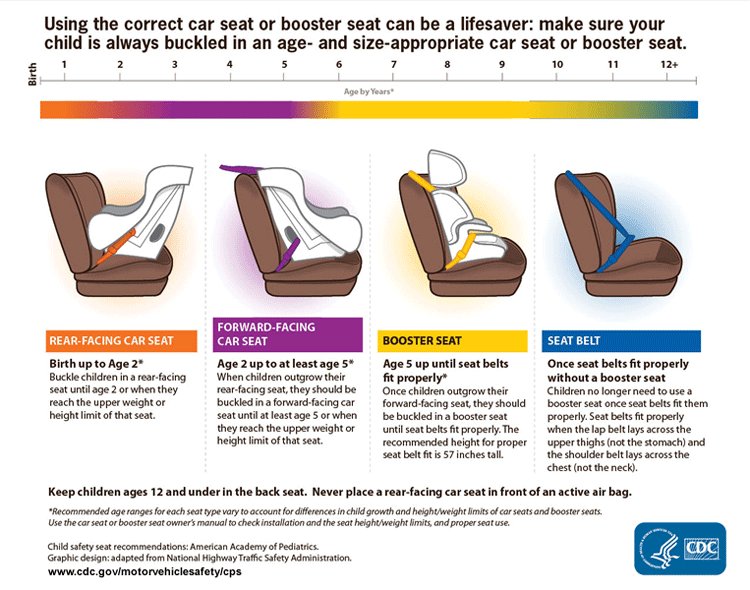California Law
Current California Law:
- Children under 2 years of age shall ride in a rear-facing car seat unless the child weighs 40 or more pounds OR is 40 or more inches tall. The child shall be secured in a manner that complies with the height and weight limits specified by the manufacturer of the car seat. (California Vehicle Code Section 27360.)
- Children under the age of 8 must be secured in a car seat or booster seat in the back seat.
- Children who are 8 years of age OR have reached 4’9” in height may be secured by a booster seat, but at a minimum must be secured by a safety belt. (California Vehicle Code Section 27363.)
- Passengers who are 16 years of age and over are subject to California’s Mandatory Seat Belt law.
When can a child graduate to a booster seat?
California law does not address graduation time from a five point harness to a booster seat. In the interest of safety, do not rush to move a child into a booster seat before they’re ready. Each time you “graduate” your child to the next seat, there’s a reduction in the level of protection for your child. Keep your child in each stage for as long as possible.
A child is ready for a booster seat when they have outgrown the weight or height limit of their forward-facing harnesses, which is typically between 40 and 65 pounds. Read the forward-facing car seat’s owner’s manual to determine height and weight limits, and keep your child in a harnessed seat for as long as possible.
Children at this stage are not yet ready for adult safety belts and should use belt-positioning booster seats until they are at least 4’9″ and between 8 and 12 years old. Safety belts are designed for 165-pound male adults, so it’s no wonder that research shows poorly fitting adult belts can injure children.
See more videos at https://www.chp.ca.gov/programs-services/programs/child-safety-seats/child-safety-seat-videos
General Info
Know the stages Make sure children are properly buckled up in a car seat, booster seat, or seat belt, whichever is appropriate for their age, height and weight.
Birth up to Age 2: Rear-facing car seat. For the best possible protection, infants and children should be buckled in a rear-facing car seat, in the back seat, until age 2 or when they reach the upper weight or height limits of their particular seat. Check the seat’s owner’s manual and/or labels on the seat for weight and height limits.
Age 2 up to at least Age 5: Forward-facing car seat. When children outgrow their rear-facing seats they should be buckled in a forward-facing car seat, in the back seat, until at least age 5 or when they reach the upper weight or height limit of their particular seat. Check the seat’s owner’s manual and/or labels on the seat for weight and height limits.
Age 5 up until seat belts fit properly: Booster seat. Once children outgrow their forward-facing seat, (by reaching the upper height or weight limit of their seat), they should be buckled in a belt positioning booster seat until seat belts fit properly. Seat belts fit properly when the lap belt lays across the upper thighs (not the stomach) and the shoulder belt lays across the chest (not the neck). Remember to keep children properly buckled in the back seat for the best possible protection.
Once Seat Belts Fit Properly without a Booster Seat: Seat Belt Children no longer need to use a booster seat once seat belts fit them properly. Seat belts fit properly when the lap belt lays across the upper thighs (not the stomach) and the shoulder belt lays across the chest (not the neck). For the best possible protection keep children properly buckled in the back seat.
Install and Use Car & Booster Seats Properly Install and use car seats and booster seats according to the seat’s owner’s manual or get help installing them from a certified Child Passenger Safety Technician.
Seat Children in the Back Seat Buckle all children aged 12 and under in the back seat.
Don’t Seat Children in Front of an Airbag Airbags can kill young children riding in the front seat. Never place a rear-facing car seat in front of an air bag.
Seat Children in the Middle of the Back Seat Buckle children in the middle of the back seat when possible, because it is the safest spot in the vehicle.
Use Proper Restraints Every Trip Buckle children in car seats, booster seats, or seat belts on every trip, no matter how short.
Parents and Caregivers: Always Wear a Seat Belt Set a good example by always using a seat belt themselves.
The above information was taken from the following sources.
https://www.chp.ca.gov/programs-services/programs/child-safety-seats#
https://www.cdc.gov/motorvehiclesafety/child_passenger_safety/index.html

